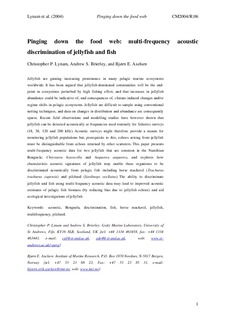| dc.contributor.author | Lynam, Christopher P. | |
| dc.contributor.author | Brierley, Andrew S. | |
| dc.contributor.author | Axelsen, Bjørn Erik | |
| dc.date.accessioned | 2012-11-20T20:18:08Z | |
| dc.date.available | 2012-11-20T20:18:08Z | |
| dc.date.issued | 2004 | |
| dc.identifier.citation | This report is not to be cited without prior reference to the authors | no_NO |
| dc.identifier.uri | http://hdl.handle.net/11250/106425 | |
| dc.description.abstract | Jellyfish are gaining increasing prominence in many pelagic marine ecosystems worldwide. It has been argued that jellyfish-dominated communities will be the end-point in ecosystems perturbed by high fishing effort, and that increases in jellyfish abundance could be indicative of, and consequences of, climate-induced changes and/or regime shifts in pelagic ecosystems. Jellyfish are difficult to sample using conventional netting techniques, and data on changes in distribution and abundance are consequently sparse. Recent field observations and modelling studies have however shown that jellyfish can be detected acoustically at frequencies used routinely for fisheries surveys (18, 38, 120 and 200 kHz). Acoustic surveys might therefore provide a means for monitoring jellyfish populations but, prerequisite to this, echoes arising from jellyfish must be distinguishable from echoes returned by other scatterers. This paper presents multi-frequency acoustic data for two jellyfish that are common in the Namibian Benguela; Chrysaora hysoscella and Aequorea aequorea, and explores how characteristic acoustic signatures of jellyfish may enable these organisms to be discriminated acoustically from pelagic fish including horse mackerel (Trachurus trachurus capensis) and pilchard (Sardinops ocellatus). The ability to discriminate jellyfish and fish using multi-frequency acoustic data may lead to improved acoustic estimates of pelagic fish biomass (by reducing bias due to jellyfish echoes) and aid ecological investigations of jellyfish. | no_NO |
| dc.language.iso | eng | no_NO |
| dc.publisher | ICES | no_NO |
| dc.relation.ispartofseries | ICES CM Documents;2004/R:6 | |
| dc.subject | acoustics | no_NO |
| dc.subject | akustikk | no_NO |
| dc.subject | horse mackerel | no_NO |
| dc.subject | taggmakrell | no_NO |
| dc.subject | jellyfish | no_NO |
| dc.subject | maneter | no_NO |
| dc.title | Pinging down the food web: multi-frequency acoustic discrimination of jellyfish and fish | no_NO |
| dc.type | Working paper | no_NO |
| dc.subject.nsi | VDP::Agriculture and fishery disciplines: 900::Fisheries science: 920::Fisheries technology: 924 | no_NO |
| dc.subject.nsi | VDP::Mathematics and natural science: 400::Geosciences: 450::Oceanography: 452 | no_NO |
| dc.subject.nsi | VDP::Social science: 200::Library and information science: 320::Knowledge retrieval and organization: 323 | no_NO |
| dc.source.pagenumber | 21 s. | no_NO |
